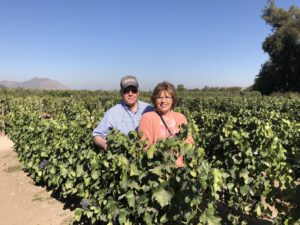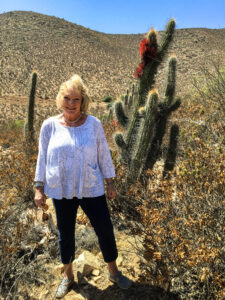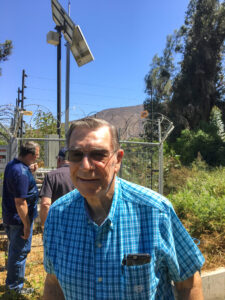C
hile is a country of 18 million people, stretching 2,600 miles north-to-south along the Pacific Coast of South America. Its dramatic landscape includes mountains, deserts, fjords, and fertile valleys. In February, I led an Irrigation Leader tour to this amazing country. We saw how farmers, water managers, and civil servants are working to fight Chile’s serious droughts and cultivate grapes, avocados, citrus fruits, vegetables, and other crops in north-central Chile’s transverse valleys. In these pages, you will read our participants’ reactions to the tour and see where they went.
 “The tour was fantastic! The way Chileans manage their available water was fascinating to see. It seems that we all have problems with how to effectively manage this golden resource. Gastón and Javier, who led us through the irrigation districts, were informative and took time to explain how the Rubicon gate systems we saw worked. The delivery systems we saw, which used lined canals, were different from the systems the North Platte Natural Resources District (NRD) uses to manage water. Our systems are not lined, and we depend on canal seepage and slop to recharge the aquifer. The practice of farming avocados on the slopes of mountains was fascinating. We really enjoyed the perfect climate during our stay and appreciated the warmhearted welcome we received from the people we encountered during the tour. We would like to thank Water Strategies, Kris, and Annick (bless her interpreting skills) for a well-planned and informative excursion!”
“The tour was fantastic! The way Chileans manage their available water was fascinating to see. It seems that we all have problems with how to effectively manage this golden resource. Gastón and Javier, who led us through the irrigation districts, were informative and took time to explain how the Rubicon gate systems we saw worked. The delivery systems we saw, which used lined canals, were different from the systems the North Platte Natural Resources District (NRD) uses to manage water. Our systems are not lined, and we depend on canal seepage and slop to recharge the aquifer. The practice of farming avocados on the slopes of mountains was fascinating. We really enjoyed the perfect climate during our stay and appreciated the warmhearted welcome we received from the people we encountered during the tour. We would like to thank Water Strategies, Kris, and Annick (bless her interpreting skills) for a well-planned and informative excursion!”
—Barb Cross, Assistant Manager, North Platte NRD; Leo Hoehn, Farmer and Irrigator, Scottsbluff, Nebraska
 “Given my professional focus on working relationships between water users and their federal partners, I was most interested, after visiting with irrigators, with what we learned at the National Irrigation Commission (Comisión Nacional de Riego, CNR). The concept of reimbursable financing of projects rather than upfront financing was intriguing. It is positive that the support for the CNR’s subsidies is stable and in fact growing, even though its leadership changes every 5 years. Finally, I was surprised that irrigators in Chile do not use the tool of their legislators’ support for their projects, but found it refreshing that they seemed satisfied enough with the support they get from the executive branch not to employ that practice!”
“Given my professional focus on working relationships between water users and their federal partners, I was most interested, after visiting with irrigators, with what we learned at the National Irrigation Commission (Comisión Nacional de Riego, CNR). The concept of reimbursable financing of projects rather than upfront financing was intriguing. It is positive that the support for the CNR’s subsidies is stable and in fact growing, even though its leadership changes every 5 years. Finally, I was surprised that irrigators in Chile do not use the tool of their legislators’ support for their projects, but found it refreshing that they seemed satisfied enough with the support they get from the executive branch not to employ that practice!”
—Christine Arbogast, President, Kogovsek & Associates
 “The tour was informative and provided me with a new appreciation for how alike people are. Irrigation delivery in Chile is similar to what it is like in the United States, and Chile has the same struggles: Improvement needs exceed financial resources, and the limiting factor is water
“The tour was informative and provided me with a new appreciation for how alike people are. Irrigation delivery in Chile is similar to what it is like in the United States, and Chile has the same struggles: Improvement needs exceed financial resources, and the limiting factor is water
It was interesting to learn that the Chilean government funds 80–90 percent of project costs and the irrigation districts keep the water savings to expand acres. Since the government started funding irrigation projects in 1985, over 470,000 new acres have been developed. In addition, the districts manage the rivers, and once a project is paid off, the project proponent has to take ownership, even with large storage reservoirs. Title transfer is mandatory
and immediate following loan payoff.
The country is very old, having been settled by Spain in 1540. We met with the Bellavista Canal Association and learned that it has been in continuous operation for over 250 years. The districts we met with have a similar organizational structure to irrigation districts in the United States and are using technology to achieve similar goals, namely, accurate water resource management with less staff.
The Elqui River Joint Board of Control delivers water to 34 canals and has as its demarcation point a Rubicon FlumeGate. Once the water passes over the gate, the board’s responsibility ends and it is up to the water users to figure out water use. As
with the Yakima Project, all districts are dependent on mountain snowpack for their water. Currently, water users are limited to just 37 percent of their allocation. In order to make to reduced allocation work, fields are fallowed and wells may be used if they predate 2004, when the government shut down all new groundwater withdrawals
in two regions. The government regulates groundwater; no such national-level regulations exist for surface water.
In was interesting to learn that water resource planning is limited to individual political regions, not watersheds. Forecasts are conducted by irrigation districts, not the government. It was interesting to hear the opinion expressed that the role of government needs to be increased, because only the government can bring people together who may not want to work together.”
—Chuck Freeman, Manager, Kennewick Irrigation District
 “Sherri and I had a great time on this trip. What I found interesting was Chilean farmers’ ability to grow crops on ground that in the United States would be wasteland. Not only did this rocky land produce crops, they were high-value crops and were grown well. When you thought the farmers had enough challenges, they would move up the sides of the mountains and grow more crops. All this was done with manual labor.
“Sherri and I had a great time on this trip. What I found interesting was Chilean farmers’ ability to grow crops on ground that in the United States would be wasteland. Not only did this rocky land produce crops, they were high-value crops and were grown well. When you thought the farmers had enough challenges, they would move up the sides of the mountains and grow more crops. All this was done with manual labor.
The people of Chile were great hosts, and it was fun getting to know them. We also enjoyed getting to know everyone on the tour. The best part about a tour like this is going to places that normally are not considered tourist destinations.
It was very interesting to see how the people of Chile were resolving the water issues that they experienced at the local level. Many of the water issues we face in the United States are the same in Chile—not enough water, too much government, and not enough money.”
—Brad Edgerton, Manager, Frenchman Cambridge Irrigation District
 “It doesn’t matter if we are in North or South America, agriculture has to continue to do its share to conserve and manage water so we can meet growing demands for food.”
“It doesn’t matter if we are in North or South America, agriculture has to continue to do its share to conserve and manage water so we can meet growing demands for food.”
—Gene Huffman, Vice President, Kennewick Irrigation District
